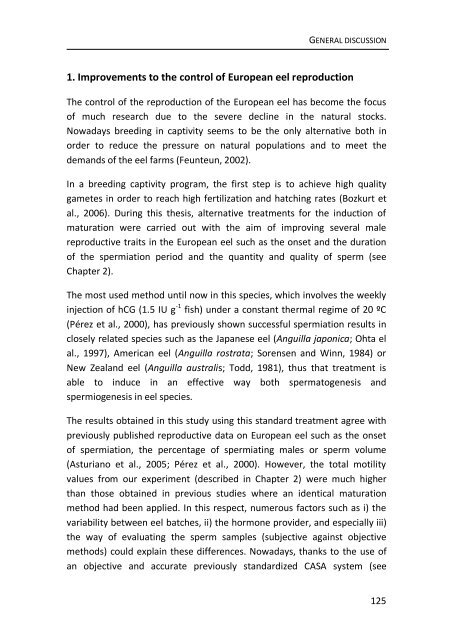chapter 3 - RiuNet
chapter 3 - RiuNet
chapter 3 - RiuNet
You also want an ePaper? Increase the reach of your titles
YUMPU automatically turns print PDFs into web optimized ePapers that Google loves.
GENERAL DISCUSSION<br />
1. Improvements to the control of European eel reproduction<br />
The control of the reproduction of the European eel has become the focus<br />
of much research due to the severe decline in the natural stocks.<br />
Nowadays breeding in captivity seems to be the only alternative both in<br />
order to reduce the pressure on natural populations and to meet the<br />
demands of the eel farms (Feunteun, 2002).<br />
In a breeding captivity program, the first step is to achieve high quality<br />
gametes in order to reach high fertilization and hatching rates (Bozkurt et<br />
al., 2006). During this thesis, alternative treatments for the induction of<br />
maturation were carried out with the aim of improving several male<br />
reproductive traits in the European eel such as the onset and the duration<br />
of the spermiation period and the quantity and quality of sperm (see<br />
Chapter 2).<br />
The most used method until now in this species, which involves the weekly<br />
injection of hCG (1.5 IU g -1 fish) under a constant thermal regime of 20 ºC<br />
(Pérez et al., 2000), has previously shown successful spermiation results in<br />
closely related species such as the Japanese eel (Anguilla japonica; Ohta el<br />
al., 1997), American eel (Anguilla rostrata; Sorensen and Winn, 1984) or<br />
New Zealand eel (Anguilla australis; Todd, 1981), thus that treatment is<br />
able to induce in an effective way both spermatogenesis and<br />
spermiogenesis in eel species.<br />
The results obtained in this study using this standard treatment agree with<br />
previously published reproductive data on European eel such as the onset<br />
of spermiation, the percentage of spermiating males or sperm volume<br />
(Asturiano et al., 2005; Pérez et al., 2000). However, the total motility<br />
values from our experiment (described in Chapter 2) were much higher<br />
than those obtained in previous studies where an identical maturation<br />
method had been applied. In this respect, numerous factors such as i) the<br />
variability between eel batches, ii) the hormone provider, and especially iii)<br />
the way of evaluating the sperm samples (subjective against objective<br />
methods) could explain these differences. Nowadays, thanks to the use of<br />
an objective and accurate previously standardized CASA system (see<br />
125
















